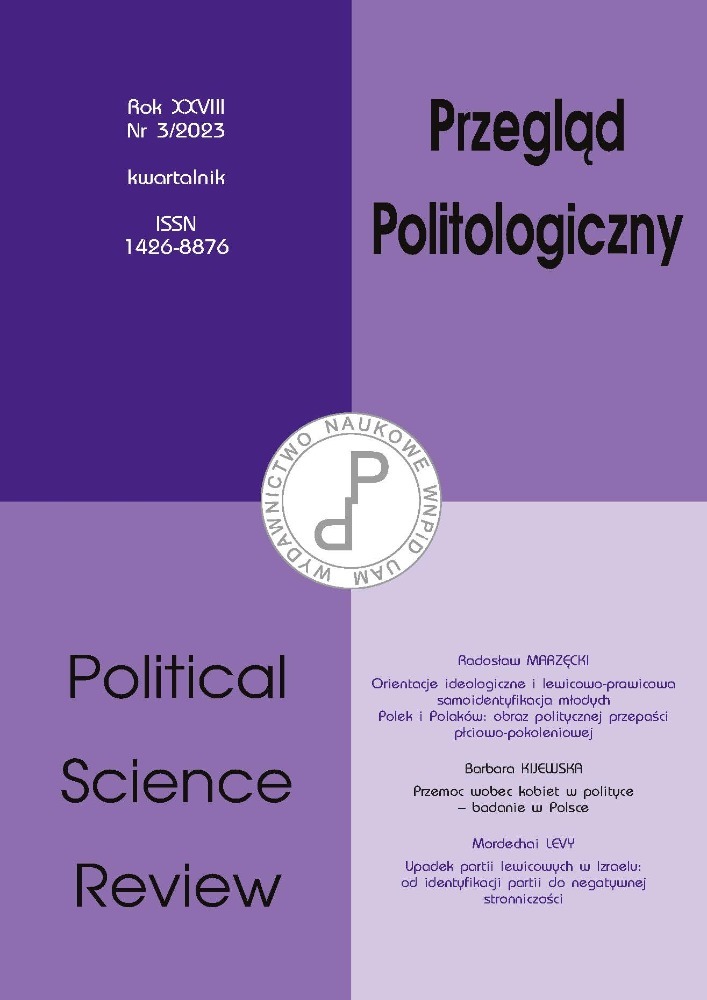Abstrakt
Partie lewicowe są najstarszymi instytucjami politycznymi w Izraelu. Powstały przed utworzeniem państwa i były dominującą siłą polityczną w pierwszych dziesięcioleciach jego istnienia. Jednak od lat 90. XX w. następuje systematyczny spadek ich władzy do tego stopnia, że w ostatnich wyborach do Knesetu, które odbyły się w 2022 r., partie lewicowe ledwo przekroczyły próg. Artykuł wyjaśnia upadek partii lewicowych i próbuje odpowiedzieć, dokąd poszli wyborcy. Splot kilku wydarzeń o charakterze lokalnym i globalnym, jakie miały miejsce w ostatnich latach, spowodował, że partie lewicowe zdystansowały się od charakteryzującej je narracji o syjonistycznym socjalizmie i przyjęły nową narrację, w mniejszym stopniu inspirującą do identyfikacji żydowskich wyborców. Głównym argumentem artykułu jest to, że wyborcy nie zniknęli, a jedynie zmienili swoje zachowania polityczne ze stanu identyfikacji partyjnej i głosowania na partie lewicowe do stanu opozycji politycznej i głosowania przeciwko partiom prawicowym. Aby zilustrować schemat zachowań, zaprezentowano dane dotyczące głosowania w Knesecie w dwóch społecznościach o różnej charakterystyce demograficznej: kibucu Mizra – gminie socjalistycznej utożsamianej z wyborcami lewicy oraz Beit-Shean – mieście będącym bastionem wyborców prawicy. Wniosek jest taki, że sposobem na powrót partii lewicowych do dominacji jest reintegracja tożsamości żydowskiej z wartościami sprawiedliwości i równości.
Bibliografia
Arian A. (1990), Politics and government in Israel, Zmora-Bitan Publishers, Tel-Aviv [Hebrew].
Arian A. (1997), The Second Republic: Politics in Israel, Haifa University Press, Zmora-Bitan Publishers, Tel-Aviv [Hebrew].
Arian A., Shamir M. (1983), The primarily political functions of the Left-Right continuum, “Comparative Politics”, vol. 15, no. 2, pp. 139–158. DOI: https://doi.org/10.2307/421673
Arian A., Shamir M. (2018), On mistaking a dominant party in a dealigning system, in: The Elections in Israel 2003, eds. A. Arian, M. Shamir, pp. 27–52, Routledge. DOI: https://doi.org/10.4324/9781351322287
Bankert A. (2021), Reflections on the past and present of research on partisan identity, “Forum”, vol. 19, no. 3, pp. 459–480. DOI: https://doi.org/10.1515/for-2021-2024
Bein A. (1976), History of the Jewish settlement in Israel, Masada [Hebrew].
Campbell A., Converse P. E., Miller W. E., Stokes D. E. (1960), The American voter, The University of Michigan Press.
Caruana N. J., McGregor R. M., Stephenson L. B. (2015), The power of the dark side: negative partisanship and political behaviour in Canada, “Canadian Journal of Political Science/Revue canadienne de science politique”, vol. 48, no. 4, pp. 771–789. DOI: https://doi.org/10.1017/S0008423914000882
Dalton R. J., McAllister I., Wattenberg M. P. (2002), The Decline of Party Identifications, in: Parties without partisan: political change in advanced industrial democracies, eds. R. J. Dalton, I. McAllister, M. P. Wattenberg, pp. 37–63, Oxford University Press. DOI: https://doi.org/10.1093/0199253099.003.0003
Drummond A. J. (2006), Electoral volatility and party decline in Western democracies: 1970–1995, “Political Studies”, vol. 54, no. 3, pp. 628–647. DOI: https://doi.org/10.1111/j.1467-9248.2006.00617.x
Filc D. (2006), Populism and Hegemony in Israel, Resling, Tel-Aviv.
Goldberg G. (1992), Political parties in Israel – from mass parties to electoral parties, Ramot – Tel-Aviv University [Hebrew].
Greenfield T. (2017), Collapse – The disintegration of the political left in Israel, Miskal – Yedioth Aharonoth, Tel-Aviv [Hebrew].
Horowitz D., Lissak M. (1977), From Yishuv to statehood, Am Oved, Tel-Aviv [Hebrew]. DOI: https://doi.org/10.1179/033443577792432926
Kenig O., Rahat G. (2022), The parties in Israel 1992–2021, The Israel Democracy Institute.
Levy M. (2016a), Changes in Israeli collective identity as a source of tension in the political arena, “Przeglad Politologiczy”, vol. 1, pp. 193–204. DOI: https://doi.org/10.14746/pp.2016.21.1.13
Levy M. (2016b), The Kibbutzim as collective political identity under a change, Doctoral dissertation, Adam Mickiewicz University, Poznan.
Pedersen M. N. (1979), The dynamics of European party systems: changing patterns of electoral volatility, “European Journal of Political Research”, vol. 7, no. 1, pp. 1–26. DOI: https://doi.org/10.1111/j.1475-6765.1979.tb01267.x
Rahat G. (2019), The decline of the group and the rise of the star(s): from party politics to personal politics, The Israel Democracy Institute.
Rahat G., Hazan R. Y., Ben-Nun Bloom P. (2016), Stable blocs and multiple identities: The 2015 Elections in Israel, “Representation”, vol. 52, no. 1, pp. 99–117. DOI: https://doi.org/10.1080/00344893.2016.1190592
Rose R., Mishler W. (1998), Negative and positive party identification in post-communist countries, “Electoral Studies”, vol. 17, no. 2, pp. 217–234. DOI: https://doi.org/10.1016/S0261-3794(98)00016-X
Shamir M., Rahat G. (2022), Four elections in two years, in: The elections in Israel 2019–2021, eds. M. Shamir, G. Rahat, pp. 1–24, Routledge. DOI: https://doi.org/10.4324/9781003267911
Sheafer T., Shenhav S. R., Goldstein K. (2011), Voting for our story: A narrative model of electoral choice in multi-party systems, “Comparative Political Studies”, vol. 44, no. 3, pp. 313–338. DOI: https://doi.org/10.1177/0010414010384372
Zhong C. B., Phillips K. W., Leonardelli G. J., Galinsky A. D. (2008), Negational categorization and intergroup behavior, “Personality and Social Psychology Bulletin”, vol. 34, no. 6, pp. 793–806. DOI: https://doi.org/10.1177/0146167208315457
Licencja
Prawa autorskie (c) 2023 Mordechai Levy

Utwór dostępny jest na licencji Creative Commons Uznanie autorstwa – Na tych samych warunkach 4.0 Miedzynarodowe.

